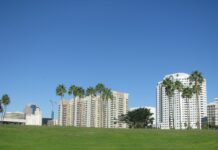Photo credit: DiasporaEngager (www.DiasporaEngager.com).
Discussion
Current evidence, including randomized controlled trial and observational data, suggests that SARS-CoV-2 rebound occurs initially as a mild illness 3–7 days after resolution of the initial acute illness, occurs in both treated and untreated patients, and is not associated specifically with receiving nirmatrelvir/ritonavir. Moreover, rebound occurs when there is variable, host-mounted immune response to infection during the course of illness. Finally, no hospitalizations or deaths were reported among outpatients who experienced rebound.
Some observational studies demonstrated a higher frequency of rebound among treated persons (10%–14%) (11,14,22) than reported by the randomized controlled trial, EPIC-HR (8,10) (Supplementary Table, https://stacks.cdc.gov/view/cdc/137156). Viral rebound might occur in persons on antiviral treatment because they are at high risk for severe disease and might have host factors, such as immunosuppression, that contribute to the natural variability in viral dynamics (21). Risk factors for rebound appear to be similar to risk for severe disease, but further studies are needed to understand whether persons with certain characteristics or underlying medical conditions are predisposed to experiencing rebound. Another important consideration is that persons receiving antiviral treatment might be at higher risk for experiencing rebound given the viral suppression related to use of treatment early in the disease course and resumption of viral replication after completion of treatment because of delayed viral clearance. This elevated risk could be due to early discontinuation of antiviral treatment or the need for longer courses of treatment among certain persons, such as those who are immunocompromised (14). Two ongoing clinical trials of nirmatrelvir/ritonavir will further characterize the frequency of rebound after different durations of nirmatrelvir/ritonavir treatment among immunocompromised subjects¶¶ and the potential benefit of nirmatrelvir/ritonavir retreatment among subjects with posttreatment rebound.***
Rebound does not likely represent reinfection or resistance to treatment (12); however, further studies are needed to confirm this finding. The FDA analysis identified potential treatment-associated mutations that were not clinically relevant among two treated patients because rebound symptoms resolved without hospitalization (8). It is important to ensure that use of antivirals does not accelerate viral evolution and result in resistant mutations, such as through counseling patients to complete antiviral treatment and monitoring for resistance using molecular analyses. Two studies demonstrated shedding of infectious virus during rebound (8,11). Comparisons of genomic strains present in both acute and rebound episodes and viral culture to determine infectiousness are important to understanding the clinical implications of rebound. In addition, a large assessment of innate and adaptive immunity and monitoring biomarkers of inflammation and cytokine storm would contribute to understanding of the underlying pathophysiology of recurrence.
Limitations
The findings in this report are subject to at least five limitations. First, standardized definitions for symptom, viral, and clinical rebound were not used across studies. Using standard definitions to accurately reflect outcomes could improve interpretability and comparisons of data across studies and settings. Most studies examined symptom or viral rebound. A definition that requires reemergence of virus after complete resolution of illness, which takes 7–10 days for a healthy adult, and a negative viral test result after resolution of initial symptoms would allow for examination of clinical implications of rebound or recrudescence, such as a dysregulated immune response (23). Second, publications about recurrences and viral kinetics might have been missed given the narrow search. Third, a major limitation of observational studies is the difficulty in verifying whether antiviral treatment courses were completed and whether vaccination status and previous infection were documented accurately. Fourth, few studies correlated symptoms with viral load, which makes the significance of recurrence of mild symptoms difficult to understand because symptoms are subjective and might not represent viral reactivation. Finally, ascertainment bias is also possible given that persons receiving antiviral treatment are closely followed, and more likely to report recurrent symptoms, which would explain the early case reports being associated with nirmatrelvir/ritonavir, the most commonly used oral antiviral in the United States.
Implications for Public Health Practice
Viral rebound can occur in persons who do and do not receive antiviral treatment and might reflect viral fluctuation that is part of the natural disease process early in the course of illness. Risk for experiencing rebound could be related to many factors, such as immunosuppression, delayed viral clearance, and overall immune response. The current literature review, along with a recently published randomized trial (8), suggests the substantial benefit of antiviral treatment among persons at risk for severe disease outweighs the risk for rebound, because rebound resolves quickly and is not associated with an increase in severity of recurring signs and symptoms. Increased education and awareness among practitioners and patients about rebound not increasing risk for hospitalization or death might increase use of COVID-19 treatment. According to NIH COVID-19 Treatment Guidelines, rebound should not deter providers from prescribing life-saving antiviral treatments when indicated to prevent morbidity and mortality from COVID-19 (1).
Source of original article: Centers for Disease Control and Prevention (CDC) / Morbidity and Mortality Weekly Report (MMWR) (tools.cdc.gov).
The content of this article does not necessarily reflect the views or opinion of Global Diaspora News (www.GlobalDiasporaNews.com).
To submit your press release: (https://www.GlobalDiasporaNews.com/pr).
To advertise on Global Diaspora News: (www.GlobalDiasporaNews.com/ads).
Sign up to Global Diaspora News newsletter (https://www.GlobalDiasporaNews.com/newsletter/) to start receiving updates and opportunities directly in your email inbox for free.






























